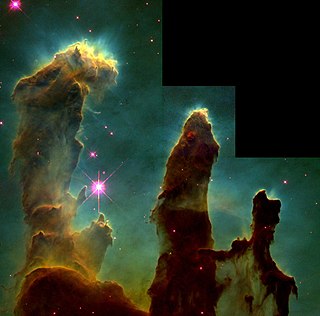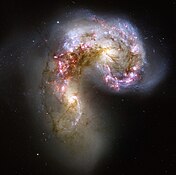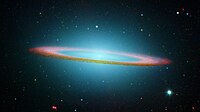Hubble space telescope
The Hubble Space Telescope (in English Hubble Space Telescope or HST for its acronym), or simply Hubble, is one of the most renowned space telescopes in modern astronomy that orbits outside the Earth's atmosphere, in a circular orbit around planet Earth at 593 kilometers above sea level, with a period orbital between 96 and 97 minutes. Named in honor of astronomer Edwin Hubble, it was launched into orbit on April 24, 1990 on the STS-31 mission as a joint project of NASA and the European Space Agency, inaugurating the Great Observatories program. Hubble can obtain images with an optical angular resolution greater than 0.04 arcseconds.
The advantage of having a telescope beyond the distortion produced by the Earth's atmosphere is that in this way the effects of atmospheric turbulence can be eliminated. In addition, the atmosphere significantly absorbs electromagnetic radiation at certain wavelengths, especially in the infrared, reducing the quality of the images and making it impossible to acquire spectra in certain bands. Terrestrial telescopes are also affected by meteorological factors (presence of clouds) and light pollution generated by large urban settlements, which reduces the possibilities of locating terrestrial telescopes.
One of Hubble's features was the possibility of being visited by astronauts on so-called service missions (SM). During servicing missions, broken items could be fixed, new instruments installed, and the telescope's orbit raised. Five service missions were carried out (SM1, SM2, SM3A, SM3B and SM4). The last one took place in May 2009 and in it the most drastic improvement of Hubble's instrumental capacity took place, when two new instruments were installed (WFC3 and COS), another two were repaired (ACS and STIS) and another one was improved (FGS). Its scientific successor is the James Webb Space Telescope (JWST), which launched in December 2021.
Technical description
Hubble has a mass of about 11 tons; It is cylindrical in shape, with a length of 13.2 m and a maximum diameter of 4.2 m. The cost of Hubble was (in 1990) US$2.8 billion. Initially, a failure in the polishing of the telescope's primary mirror made by Perkin Elmer produced slightly out-of-focus images because its outer edge was flatter than expected (only four hundredths of a millimeter) causing spherical aberrations. After this terrible negligence, it took three years for a manned shuttle (STS-61) to install an optical correction system capable of correcting the primary mirror defect, called COSTAR (COSTAR, initials in English for optics corrector as an axial replacement for the space telescope) reaching the resolution specifications initially provided.
Hubble is a reflector-type telescope and its primary mirror has a diameter of 2.4 m. For the exploration of the sky, it currently incorporates four instruments with the capacity to obtain images and spectra, a spectrograph and three fine-guided sensors that can act as interferometers. To generate electricity, two solar panels are used to power the cameras, the four motors used to orient and stabilize the telescope, the cooling equipment for the instruments, and the telescope's electronics. Likewise, Hubble has rechargeable batteries from the solar panels that allow it to use the stored electricity when the Earth eclipses the Sun, or when the orientation of the solar panels is not appropriate.
Service missions
From its design, Hubble was envisioned as a space telescope that could be visited by the space shuttle. The reasons for that ability are:
- To be able to repair damaged elements. Space is an aggressive environment for a satellite due to the effect on electronic elements of the charged elementary particles that move at high speed and the possibility of impacts with microparticles. For that reason, it was clear from the beginning that some parts of the Hubble would fail in a not very long time.
- Install new instruments, whether scientific instruments or other parts of the telescope. Given the rapid evolution of the technology, the detectors or computers (by putting two examples) available during the long life of the telescope are superior to those that were originally installed before launch. The ferry visits allow us to update these elements and thus improve Hubble's capacity.
- Maintain the orbit of the telescope. Due to the friction with the atmosphere (very tenuous but not non-existent at that height), the telescope is slow and, as a result of the terrestrial gravitational attraction, it loses height. Every time the space shuttle visits it, it pushes you to a slightly higher orbit.
The First Service Mission (SM1)
The first servicing mission was carried out with the shuttle Endeavor (STS-61) in December 1993 and lasted ten days. The SM1 plan was strongly conditioned by the spherical aberration detected three years earlier in the primary mirror. The two most important repairs were the replacement of the High Speed Photometer (HSP) with the COSTAR corrective optics and the installation of the Wide Angle and Planetary Camera 2 (WFPC2) in place of the original camera (WFPC). The purpose of COSTAR was to achieve the correct focus of the other three original axial instruments of the telescope (the Faint Object Camera or FOC, the Faint Object Spectrograph or FOS and the Goddard High Resolution Spectrograph or GHRS). The WFPC2 already incorporated its own correction for the effect of spherical aberration of the primary mirror. In addition, two new solar panels, four gyroscopes, two electrical control units, two magnetometers and a new on-board computer were installed. Finally, the HST's orbit was raised for the first time since its launch.
The Second Service Mission (SM2)
The second servicing mission was carried out with the shuttle Discovery (STS-82) in February 1997. In it, two pre-existing instruments (GHRS and FOS) were replaced by two new ones, the Imaging Spectrograph of the Space Telescope (STIS) and Near-Infrared Multi-Object Camera and Spectrometer (NICMOS), a tape data storage system was replaced with a solid-state one, thermal insulation was repaired, and the telescope's orbit was raised. NICMOS's refrigeration system did not perform as specified, reducing its lifespan from 4.5 years to 2 years.
The Third Servicing Mission (SM3A)
The third servicing mission was carried out with the Space Shuttle Discovery (STS-103) in December 1999.
The Fourth Service Mission (SM3B)
The fourth servicing mission was carried out with the shuttle Columbia (STS-109) in March 2002.
The Fifth Service Mission (SM4)
The fifth service mission was carried out with the shuttle Atlantis (STS-125) in May 2009. This was the last service mission and lasted 11 days, seven crew members participated in it with the objective of repairing and adding new instruments to the telescope.
On June 14, 2006, the Advanced Camera for Surveys (ACS), one of the instruments considered critical on the telescope, stopped working. The cause was an excessive voltage in the main power supply circuit that was corrected by activating the backup system. On June 30, the ACS returned to work correctly. On October 31, 2006, the NASA Administrator (Michael D. Griffin) announced approval for a sustainment mission. On January 27, 2007, the ACS stopped working again due to a short circuit in the ACS. At first, it was thought that the damage was irreversible for all its detectors (three in total). On February 19, 2007, it was possible to revive one of them remotely (the SBC, Solar Blind Channel) and the manned mission carried out in 2009 managed to repair another detector (the WFC, Wide Field Channel). However, the third detector (HRC, High-Resolution Channel) continues to be inoperative.
This 11-day mission involved the installation of new batteries, the third wide-angle camera (WFC3), and a new spectrograph (COS), as well as repairs to the gyros, ACS, and STIS.
With this fifth mission complete, Hubble is expected to reach the end of its useful life. Currently, the exact date of the end of Hubble is uncertain, since it depends on the life of the gyroscopes, batteries and atmospheric braking (correctable).
On December 25, 2021, NASA launched the James Webb Space Telescope, a next-generation telescope for near- and mid-infrared observing. James Webb is considered a complement to Hubble, as it observes in a different range of the electromagnetic spectrum.
Rescue by retired technicians
On June 13, 2021, Hubble's payload computer, which controls and coordinates the science instruments aboard the telescope, suddenly failed. When the main computer stopped receiving the signal from the payload computer, it automatically put all of Hubble's science instruments into sleep mode. All attempts by the team to reboot the crashed computer through the main computer failed. While important Hubble components were installed in duplicate, just in case, the backup computer had never been used since the telescope launched in 1990. To be sure, Nzinga Tull, Hubble's emergency team leader, assembled some former employees, as repairing a telescope built in the 1980s required employees' knowledge of the entire history of Hubble. Former employees who had already been involved in the construction of the telescope were still familiar with the old control and data processing unit of the payload computer. Other NASA retirees found the decisive clues to the correct procedure in original Hubble documents that were 30 to 40 years old.
Thanks to the joint effort, the standby computer was successfully commissioned on July 15, after an enforced five-week hiatus. Two days later, the instruments again provided fascinating photos of distant galaxies, beginning with two merging galaxies in Capricorn with three spiral arms. Thus, the space telescope was fully operational again thanks to the help of NASA retirees.
Data collected about the origin of the universe
Hubble is making theorists rethink some of their ideas about the age of the universe. In fact, the current idea is faced with a paradox. The latest data from Hubble, according to Wilford, a science writer for The New York Times, "convincingly suggests that the universe may be much younger than scientists estimated.". It may not be more than eight billion years old,' instead of earlier estimates of about fourteen billion. The problem is that "some stars are taken for granted to be about twelve billion years old."
Submitted images
It did not take long to show that it had been worth correcting the optical system. In June 1994, Time magazine reported that Hubble had found strong evidence to support the existence of black holes. NASA announced that it had discovered a disk-shaped cloud of gases that rotates at breakneck speed. It is about 50 million light-years away, at the center of the galaxy M 87. It is said to have an estimated mass of between 2 and 3 billion stars the size of the Sun, but squeezed into a space the size of the Solar System. Scientists estimate that the gas disk has a temperature of 10,000 degrees Celsius. The only explanation that can currently be given for this phenomenon is the existence of an enormous gravitational force exerted by a mammoth black hole, around which the disk revolves.
Hubble also sent back amazing images of Comet Shoemaker-Levy 9 as it headed on a self-destructive path to Jupiter, where it disintegrated in July 1994. Hubble's images of galaxies are so sharp that a scientist He described the work thus: "A slight change in the mirror, a giant step in astronomy." According to the Investigación y Ciencia magazine, today "Hubble's resolution is double that of the best instrument installed on Earth, and thanks to this it can clearly observe a volume of space a thousand times greater than other telescopes."
Black holes
The sharp vision of the Hubble Space Telescope has demystified the mysteries of supermassive black holes, including their abundance and influence on the evolution of the universe. Einstein's theory of General Relativity described the characteristics of these objects collapsed by gravity. His theory demonstrated a light-swallowing event horizon, which prevented telescopes from perennially looking directly at these objects.
The term "black hole" it was not adjudicated until sixty years later by astrophysicist John Wheeler. In the early 1970s, the first black hole candidate was Cygnus X-1, discovered thanks to X-rays from ultrahot material orbiting the black hole and orbiting a star. The black hole is fifteen times more massive than our sun.
In the first half of the 1990s, Hubble began to provide evidence for the existence of massive black holes weighing billions of solar masses. The most massive known to date is TON 618, with 66 billion solar masses. Thanks to Hubble's ability to discern opaque objects amid the brightness of the stellar neighborhood, the space telescope made definitive observations that quasars—very distant, compact objects that emit intense radiation—inhabit the nuclei of galaxies. These galaxies are swamped by the glow emitted by quasars. Hubble revealed that most galaxies that collide with other galaxies in a violent process give birth, according to the theory, to central black holes. Enshrouded in gas, the black hole loses some of its material in the form of jets of plasma that shoot out from the center of a galaxy, an event that was effectively resolved by Hubble.
Subsequently, Hubble reinforced the idea that supermassive black holes could be measured, which confirmed the first observations of their existence. In 1997 astronomers observed the closest mini-quasar, the bright nucleus of a giant elliptical galaxy, M87. Astronomers used spectroscopy (which splits starlight into different colors) to "weigh" a black hole to see if the amount of its invisible mass exceeded the mass attributed to stars. Hubble spectrography quantified the velocity of gas trapped in the gravitational field at the center of a black hole. The extreme speeds indicated the presence of an ultracompact mass that could be explained as a black hole.
Astrophysicists used the speeds at which stars and gas gravitate around a black hole to classify them into active galaxies and passive galaxies. A Hubble census of galaxies showed that supermassive black holes are usually found at the center of galaxies; the study suggests that black holes are linked to their birth and evolution. The idea was reinforced thanks to the Hubble observations: the mass of a black hole is related to the total mass of the bulge of stars in the nucleus of a galaxy. The more massive the bulge, the more massive the black hole. This relationship implies that there is an exchange mechanism between the growth of a galaxy and its central black hole.
Numbers
- At the time of launch was the size of a tanker or a four-story building, 13 meters long and 4 in diameter, and a weight greater than 12 tons.
- The most sophisticated camera of the Hubble space telescope has created a mosaic image of a large piece of the sky, which includes at least 10,000 galaxies.
- Hubble is 593 km above sea level.
- With the Hubble Space Telescope, approximately one million objects have been observed. In comparison, the human eye can only see about 6000 stars at a glance.
- HST observations, about 500 000 photographs, occupy 1420 optical disks of 6.66 GB.
- Hubble orbits the Earth to some 28 000 km/h, turning our planet around every ninety-seven minutes.
- Despite the high speed at which the Earth orbits, the telescope is able to point to a star with enormous precision (the diversion is less than the thickness of a human hair seen at a distance of one kilometre and a half).
- Hubble has an index with a detailed position of fifteen million stars (catalogue H. G. S. C. or Hubble Guide Star Catalogue) that allows you to point with great precision to your goals.
- The total distance that has travelled around the Earth is about 3000 million kilometers, higher than it would be to make a one-way trip to Neptune.
- Astronomers from more than forty-five countries have published the discoveries made with Hubble in 4800 scientific articles.
Image gallery
Contenido relacionado
Hybrid
Frankeniaceae
Atomic physics










